1. Introduction
How do classicists determine their research questions? Some questions in the Humanities are themselves traditional and keep attracting new approaches and eliciting new answers. Examples are the workings of Athenian democracy, the interpretation of the poems by Homer, the Greek tragedians, Virgil or Horace, or establishing the correct text of various classical authors on the basis of a detailed study of the manuscript tradition and our still-expanding knowledge of the morphology and syntax of Greek and Latin. However, while classicists study a historical period (the Mediterranean world from 800 BCE to about the fifth century CE), they are themselves inevitably children of their time, and pressing new questions circulating in contemporary society have always inspired new ways of looking at ancient texts and times. This is how the emancipation movements of the last century provoked revolutionary new studies on women in Antiquity, Greek homosexuality, or the relationship between ‘European’ and ‘African’ culture.Reference Dover 1 – Reference Bernal 3
Nowadays, a topic that is high on the societal agenda is that of ‘innovation’, the inspiration for many government policies, and a word frequently cropping up in the media. It is striking, however, that the primary cultural assumptions about and associations with ‘innovation’ steer us in the direction of technology, the natural sciences, and the medical and life sciences. We tend to delegate the issue of innovation to these domains, although research suggests that unless ‘the human factor’ is taken into account, new inventions are unlikely to make it into established innovations.Reference Volberda and ten Bosch 4 – Reference Maclaine Pont, van Est and Deuten 7 I will use ‘innovation’ here as the adoption by a relevant social group of an idea, practice, technique, or object, where this adoption has not yet occurred. The ideas, practices, techniques, or objects are forms of purposeful or intentional change to solve newly identified problems or to cope with old issues in as yet unexplored ways. In this sense, innovation is opposed to ‘invention’, the production of such an idea, practice or object. Innovation is what is perceived or constructed as innovation, the successful adoption of something ‘new’. It can refer both to a process in which it is hard to identify specific agents, and to the activity of bringing about the kinds of change referred to above. In cases where innovation seems to fail or falter, it is frequently possible to point out where that human factor has been ignored or neglected. An example of such initial neglect of sociocultural information was the introduction of the vaccination campaign against the Human Papilloma Virus in the Netherlands. Two major technical and medical breakthroughs had first established that this form of cancer is caused by a virus, and, second, had created a vaccine. The only thing left to do was to persuade the relevant population (girls in their early teens, who had not yet had sexual intercourse, and, importantly, their parents) to get the vaccination. The initial government attempt to do this failed on several fronts: official communication went by ‘snail mail’ while worried mothers on the internet were warning each other that the vaccination could be lethal. There was the misplaced hope that the rebuttal by medical specialists would carry automatic authority. Furthermore, the societal reluctance to think of 13-year old girls in terms of sexuality was reinforced by opponents coining the label ‘Virgin shots’. The initial campaign was not very successful. 8
It was the ubiquity of ideas about innovation combined with our perception of the accompanying low interest in relevant sociocultural factors and failure to use insights from the Humanities and Social Sciences in issues of innovation, that opened classicists’ eyes to the issue of innovation in classical antiquity: we realized the breadth of its reach into all recesses of human culture far beyond the technical domain, and the possibilities for the qualitative, conceptual, and interpretation-oriented Humanities to contribute to its study.
2. A Hub of Innovation: Classical Athens
For many years, a standard view of ancient Greek and Roman society has held that they were, in a famous formulation, ‘in the grip of the past’.Reference van Groningen 9 In mid-fifth-century BCE Athens, for instance, the flourishing literature is constantly evoking the mythical past and the Homeric heroes before Troy. When the Greeks defeated the invading Persian army, in the first quarter of the fifth century BCE, they instantly related this great achievement to that of their Homeric predecessors. The heroic nature and noble customs of the ancestors are commonly invoked in many genres. And yet, a recent book on ‘the Greeks and the New’ counters that in fact the second half of the fifth century is one of the most innovative periods ever.Reference D’Angour 10 , Reference Ingham 11 Everything is new, and one fascinating aspect of this realization is how relevant it is not to restrict the notion of innovation to the technical, scientific or medical domains: innovation is everywhere. The uniquely new political system of Athenian democracy is put in place. The Athenians start using coined money on a grand scale (an invention of seventh-century BCE Lydia, which is now becoming an accepted innovation). Large-scale building projects, in part necessitated by the destructions caused by the Persians, are undertaken: the Acropolis is built, with the famous Parthenon, the temple for goddess Athena, as its crowning glory. The Athenians create a theatre, in which they can produce the performances of entirely new literary genres invented in this period: tragedies and comedies. The theatre productions themselves stimulate the design of theatrical machinery. One such machine is the so-called ekkuklêma, ‘roller-outer’, which is used as a convention to make visible to the spectators the invisible inside of the stage-building (representing, for instance, a royal palace). For example, if people died, committed suicide or murder in a Greek tragedy – a not infrequent occurrence – this would not be performed on stage; however, the results, the dead bodies, were displayed to the audience, and the ekkuklêma was used to make this possible. It consisted of a wheeled platform that could be pushed ‘outside’, to where the spectators were (Figure 1, left), or, in a different reconstruction, it took the form of a revolving platform.Reference Pickard-Cambridge 12 – Reference Lucarini 14 I will return to this in Section 4.
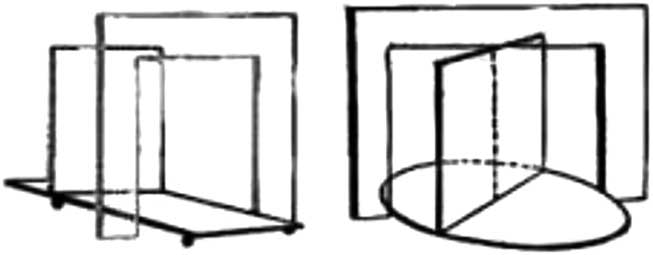
Figure 1 Two reconstructions of the ekkuklêma by A.C. Mahr (1938) The Origin of the Greek Tragic Form: a Study of the Early Theater in Attica (New York: Prentice Hall), Figs 27(a,b).
The theatre productions were also a religious innovation: they took place in the context of a religious festival devoted to Dionysus, the god of theatre. Moreover, they were also eminently political, in the sense that they were a polis affair, an event attended by all citizens, who were thereby also provided with a common set of cultural references. Many plays thematized issues that are important to any community, for instance, the relationship between individual, family, and political community. However, what does one do when these different loyalties come into conflict? No easy solutions were offered.
3. Athenian Innovation and Various Forms of Anchoring
Fifth-century Athens, then, was a hotspot of innovation. This led the author of The Greeks and the New to the conclusion that the notion of ‘in the grip of the past’ must be wrong.Reference van Groningen 9 , Reference D’Angour 10 How can the Athenians have been in the grip of the past when they were such innovators? The answer currently proposed by a research team of Dutch classicists is a different one. ‘The grip of the past’ is not a bug in an overall innovative society: it is a feature. Innovations may become acceptable, understandable, and desirable when relevant social groups can effectively integrate and accommodate them in their conceptual categories, values, beliefs and ambitions. This is the case when they can connect what is perceived as new to what they consider familiar, known, already accepted, when, that is, innovations are ‘anchored’. Anchoring can take place ‘horizontally’, between different contemporary domains, or ‘vertically’, when creative constructions of the past are used as an anchoring device.
In Athens, the new democratic structure of the ten tribes, or phylai, each of which combined a number of citizens from the city, the coast and the inland, was given familiarity by naming each of them after a mythological hero (the so-called Eponymous Heroes). The monument of the Eponymous Heroes, carrying bronze statues of all of them, was Athens’ information centre, where announcements were published.
The building programme on the Acropolis was necessitated by the devastations caused by the Persians. In the middle of the Acropolis, between the newly built Parthenon and the Erechtheion, were the remains of the old temple of Athena, likely still partially intact or restored and in use, its broken fragments recognizably used to reinforce the North wall of the Acropolis.Reference Ferrari 15 These remains, part of a ‘choreography of ruins’,Reference Ferrari 15 would have reminded the Athenians of the historical events that led to the new building activities, which were therefore securely ‘anchored’ in the past.
Coins such as the famous Athenian tetradrachms looked properly ‘Athenian’, familiar and trustworthy, because they had a portrait of the goddess Athena on its obverse, and her sacred animal, the owl, on the reverse: the coin was ‘anchored’ in a shared notion of the divine protector of the city (Figure 2). This is an anchoring practice that would be long-lived: local rulers and invocations of divine assistance are among the most common ways to mutually connect the economic, political and religious domains. The reverse of the US 10-dollar bill has the caption ‘in God we trust’ (Figure 3). The Dutch guilder coin used to have the phrase ‘God zij met ons’ (‘God be with us’) engraved on its rim.
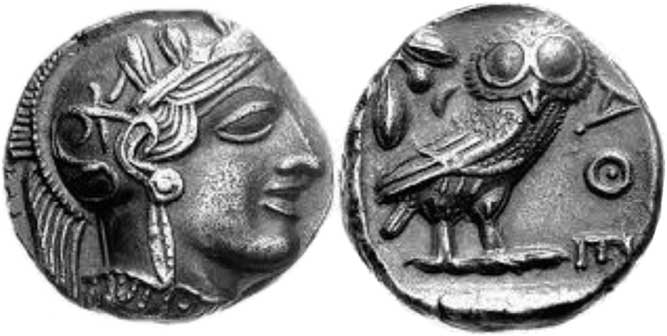
Figure 2 Athenian tetrachdrachm, showing the goddess Athena (a) and her owl (b). The letters alpha, theta, eta, form the beginning of her name – and that of Athens.

Figure 3 US ten-dollar bill.
The use of coinage is an interesting case for ‘anchoring’ because it is a perfect illustration of the dynamic nature of anchoring. Whereas initially it may have been the coinage itself that was in need of anchoring, as time went on coins themselves could function as an anchor for other innovations. When Queen Beatrix of the Netherlands announced her intention to abdicate (2012), a coin was issued (2013) showing the Queen in the foreground, with her son and future successor right behind her; in a later commemorative coin the roles were inverted: Willem Alexander took the foreground, with his mother behind him, the king facing in the opposite, new, direction as is traditional with royal successions in the Netherlands (Figure 4(b)). A monarchy is basically a family business, which has the advantage of evoking an automatic sense of continuity. Genealogy is one of the strongest anchoring discourses that we know.Reference Sluiter 16 The coins underlined this. When Willem-Alexander was inaugurated in 2013, another coin was issued, this time showing the new King on the obverse and ‘the people’ on the reverse. The motto of the House of Orange (je maintiendrai) was cleverly shared between the two sides, emphasizing the King’s commitment to democracy, and suggesting commonly shared values between King and people (Figure 4(c)). Clearly, the euro did not derive increased authority from the fact that Willem Alexander was depicted on it. On the contrary, the legitimacy of the new monarch was confirmed by the fact that he got to be on our familiar, even traditional, euro. Coinage had itself turned into an anchoring device.

Figure 4 Dutch euro coins marking the succession of monarchy, showing Queen Beatrix (a); Beatrix (foreground), Willem Alexander (background), and Willem Alexander (foreground), Beatrix (background) (b); and Willem Alexander and the people (obverse) (c).
4. The History of the Revolving Door
In thinking about ‘anchoring’ and the ‘old’ and the ‘new’, it is worth taking a closer look at the theatrical equipment of the ekkuklêma. Two alternative reconstructions were made of this appliance (Figure 1) – it is possible that both versions were in use at some point.
For now, I am particularly interested in the reconstruction shown in Figure 5(a), which is based on a number of ancient so-called ‘scholia’, annotations provided by ancient scholars on the text of the tragedians, in which a word for ‘to rotate’ or ‘turn around’ is used.Reference Pickard-Cambridge 12 – Reference Lucarini 14 In this version, we see a revolving platform, which comes into view when the two-winged panel originally closing off the stage building is pushed on one side and turns on an axis. This construction looks a lot like a revolving door, but if we check the history of the revolving door, we see that a patent for that invention was given to Theophilus Van Kennel in 1888, who was even inducted into the Inventors’ Hall of Fame for this idea in 2007 (Figures 5(b) and (c)). Why are we correct in not thinking that the Athenians had invented the revolving door in spite of the obvious closeness in design? The invention of the revolving door belonged in a very specific socio-historical and technological context. In late-19th-century Chicago, a number of inventions and innovations succeeded each other very rapidly. High-rise buildings were created, and the elevator was invented. Elevators can create a piston effect: the air pressure will push the door open, something that is prevented by the wings of the revolving door, which experience equal pressure. Chicago is also frequently cold and windy, and when a building such as a department store is frequently entered or exited, it is important to think of a way to limit heat loss. This was the socio-cultural context of the invention of the revolving door. It was conceptualized as a mechanism to enter and exit buildings and it was potentially useful in that it addressed a number of issues in Chicago buildings.
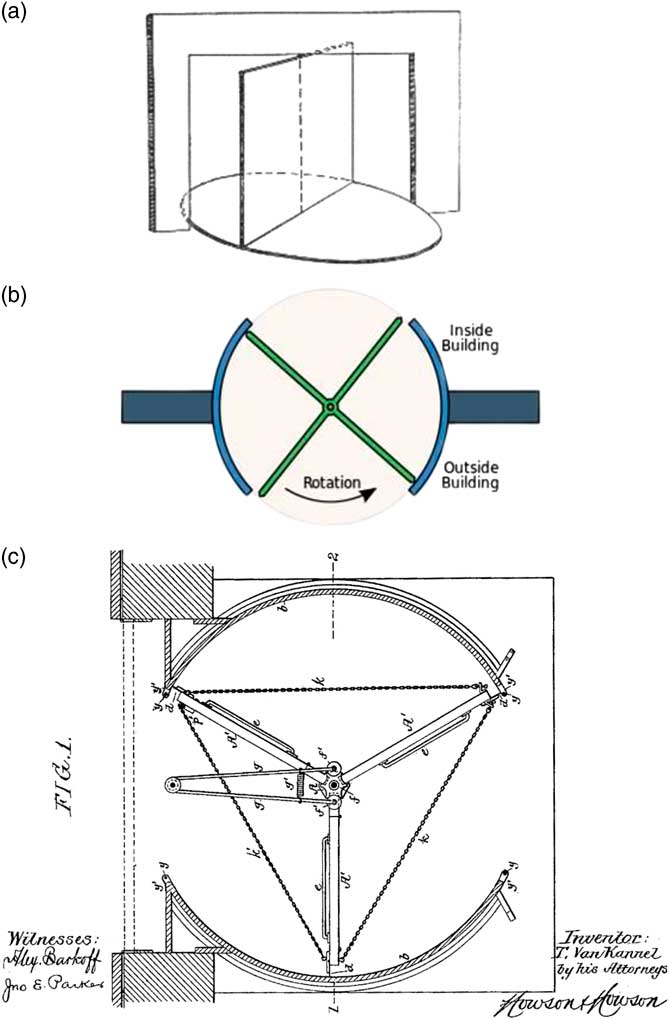
Figure 5 (a) Reconstructions of the ekkuklêma by A.C. Mahr 1938, Origin of the Greek Tragic Form, fig. 27b; (b) design of revolving door; (c) patent drawing of revolving door by Theophilus Van Kennel 1888.
None of this applies to the Greek situation. No source about the ekkuklêma ever discusses it in terms of a door, but it is always a conventional solution to a concrete problem: how can you make visible to your audience what happened inside a building? It must have been accepted on those terms by everyone in the theatre, technicians and audience, and hence there is simply no conceptual anchor made available that would have led the Athenians to perceive of it as a ‘door’, nor is there a potential usefulness to this invention beyond its immediate theatrical function. If we took a teleological approach to the history of the revolving door, the ekkuklêma would be a dead-end first step, but this is poor historical method. In the Greek context, the ekkuklêma was a successful theatre machine and had nothing to do with doors.
5. Technology Solves a People Problem
In many cases, even to define something as a problem for technology is a matter of the human factor. This is one of the principles of the ‘Social Construction of Technology’ or SCOT.Reference Pinch and Bijker 17 , Reference Bijker 18 A striking example of a technological invention intended to solve a specific ‘people problem’, effectively anchored only for that group to the exclusion of others, is a contraption that saved the Romans in a battle against the Carthaginians at the beginning of the first Punic war (264–241 BCE).Reference Meijer 19 , 20 It illustrates the interaction between humans and artefacts that is at the basis of behavioural Archaeology.Reference LaMotta and Schiffer 21
At the beginning of this war, the two opponents exercise their power in different domains: the Carthaginians dominate the seas, the Romans have an excellent land army. The Romans are the first to venture onto their opponents’ terrain: the historian Polybius tells the story of how they capture an enemy ship and have it copied, while the soldiers practice rowing on dry land. The Roman consul, Scipio, is so inexperienced that he allows himself to be trapped inside a harbour: he loses part of his fleet and is taken captive. The second consul, Duilius, takes over command of the fleet. But it is clear that something extraordinary is needed. Polybius reports that ‘someone’, motivated by the frustrating fact that the ships were badly fitted out and hard to manage, invented the corvus, the ‘crow’ or harpago (‘gripper’). Were the ships ‘hard to manage’ for their poorly prepared crews or because something was the matter with the ships themselves? Whatever was the case, the contraption of the corvus saved the day (Figure 6).
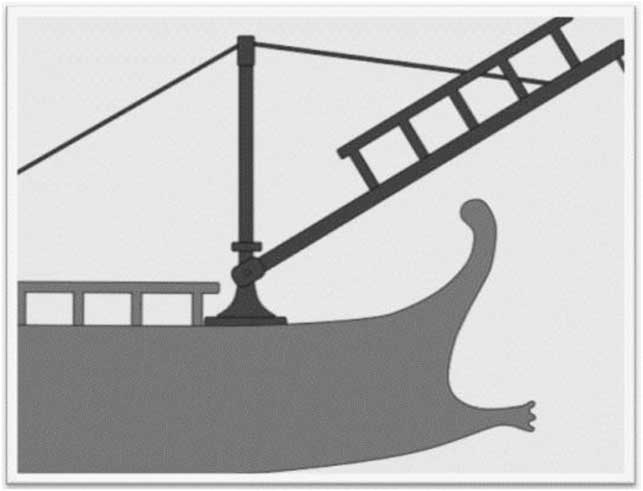
Figure 6 The corvus, boarding bridge; Wikimedia commons, Creative Commons Attribution-Share Alike 2.5 generic.
It consisted of a pole, 7 m high, with a pulley at the top and a gangway (actually referred to as ‘ladder’ in Polybius’ Greek) attached to it. The gangway had a railing so that the men could hold on to it while entering the enemy ship. The whole contraption was capable of swinging around the pole, so that from whichever angle the enemy would approach, it could be swung down onto their ship. At the end of the gangway, there was an iron pin, that would be sunk into the enemy deck and thus secure the gangway.
Polybius’ description of what happened offers an arresting picture of ‘anchoring innovation’. First of all, the description of the entering bridge contains a number of elements that would have made its operation understandable and familiar for the Roman soldiers: the gangway is called a ‘ladder’, suggesting one can climb over it, while the name corvus, crow, provides a conceptual and embodied anchor in the domain of nature for the way in which the gangway swoops down on the enemy and grabs it with its claw (pin). Nature is a common source of inspiration for names for machines. But most importantly, the soldiers now know that they can give battle in a way with which they are familiar and at ease: in man-to-man combat, as if on land. Notice that the corvus is not an innovation that improves the boats per se: it does not affect sailing, rowing, landing or anything else; but it solves the problem of incompetent people on board.
The Carthaginians, however, are clueless as to what it is they are seeing. They approach the Roman fleet as if they are simply coming to collect their loot. The contraption, which they cannot understand, and, indeed, which makes no sense from the point of view of a competent seaman, takes them completely by surprise. They are bewildered by their opponents’ equipment, and they take to flight, taken aback by the unheard of novelty (kainotomia, a negative word for ‘the new’) of the event. They lose 50 ships.
It is an intriguing thought that the young Sicilian Archimedes must have been close by when the corvus was designed by ‘someone’.
6. Anchoring Innovation in Different Domains: Visual Culture
The way in which human beings deal with change and give it a place may differ between historical periods and cultures in concrete details and practical implementation, but the process itself can easily be illustrated across different domains both from classical antiquity and modern society. Our research programme envisages the domains of language and rhetoric; literature and art; philosophy and religion; politics, law, economy and the military; technology, science, and material culture; and, finally, the reception of classical antiquity in later periods. Here, I will restrict myself to an ancient and modern example from the technical and visual domains, followed by a political one in Section 8.
Consider Figure 7. This is part of the monumental architrave of Temple C at Selinus (Sicily), dated to the middle of the sixth century BCE. The picture shows the so-called ‘triglyphs’, and in between them a ‘metope’ (size 4.5×4.3 m) with a relief depicting Perseus cutting off the head of Medusa. This relief is clearly the main part of the visual decorative programme of this part of the temple. Right over the triglyphs, however, carved out by hand from the stone here and elsewhere, are three rows of six guttae ‘droplets’. The puzzling thing about these guttae is that they are clearly costly to produce, and yet not functional in the construction of the building (although they may have some use in channelling water away from the reliefs). Several solutions have been suggested for this conundrum. It is possible that they were a genuine creative invention, one that caught on because it was first applied in a much admired temple: that example would then serve, in our terminology, as the ‘anchor’. However, even in Antiquity, a different solution was proposed. Temples were originally built in wood, and only later in stone. The architect Vitruvius suggested that the guttae were an imitation in that new material of the projecting pegs used functionally in a wooden construction. Although this theory of ‘petrification’, translating a wooden construction into stone, is no longer accepted without modification, it is still a possibility that functional wooden pegs, not necessarily originally in the position or distribution in which we see them here, are conceptually at the basis of the stone guttae. The stone construction is then visually connected to earlier constructions in wood, although this anchor may have undergone creative adaptations or evolution in its execution. 22 – Reference Wilson Jones 24
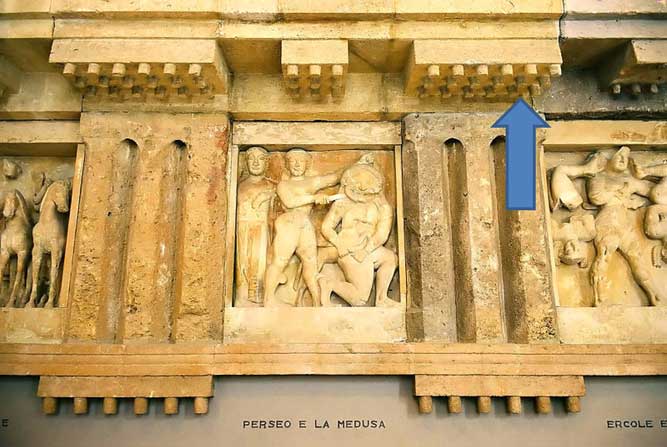
Figure 7 Triglyphs and metope from Temple C, Selinus, sixth century BCE. Guttae at top of picture, arrowed.
Now compare this with Figure 8. This is an electric car, and we see someone recharging the battery. However, that is not really what we perceive when we look at the picture, nor may it be how the first owners of these cars conceived of their actions. Recharging a battery basically comes down to plugging the car into an electrical outlet. The socket on the car can be anywhere, since there is no connection to a fuel tank. However, certainly in the first generation of electric cars, the socket was in the exact place where the tank used to be. And, in general, the whole process of recharging the battery was anchored in familiar procedures and visual cues connected to taking fuel: the way the pump is shaped, the ‘nozzle’ (really the plug), the tube leading from ‘pump’ to ‘nozzle’. It all ineluctably evokes familiar and traditional forms and procedures. Of course, this is also a matter of clever design: the procedure looks familiar, yet is stylized at the same time to look hip and new. Visual anchoring supports the acceptance and successful adoption of innovation.

Figure 8 ‘Taking fuel’ in (recharging) an electric car.
Designers can use these forms of visual anchoring for different purposes: compare Figures 9 and 10.

Figure 9 A smart-phone icon for accessing digital reading material in the shape of a wooden newsstand.
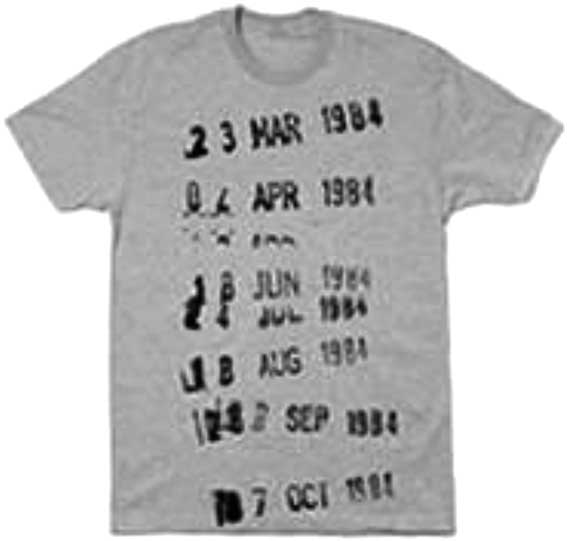
Figure 10 A T-shirt with print of an old-fashioned library card.
The wooden kiosk or newsstand, functioning as the smart-phone icon that one may use to access digital reading material, is an example of ‘skeuomorphism’: the digital interface imitates the design of a familiar object from the physical world, a perfect form of ‘anchoring’. There is a functional relationship between the depiction and what it evokes, and the action the user is supposed to take. However, in Figure 10, the situation is different. True, an old-fashioned item is depicted, a hand-stamped library card from before the digital era. But is there supposed to be a functional relationship to the wearer? If pressed hard, one might interpret the T-shirt as an ironic statement that no one has shown an interest in the wearer since 1984 (the ominous last date on the card, bringing to mind George Orwell’s classic). But this is hardly likely, since the company advertising this T-shirt is clearly targeting a young audience, who may not yet have been born in 1984, let alone ever have used these cards. The slogan of the company is ‘NOSTALGIA’, so this is best taken as a ‘simple’ expression of emotional attachment to the past and a not-too-serious form of longing for it. One of the tasks of our research programme will be to look into the relationship between ‘anchoring’ and phenomena such as nostalgia, archaism, or classicism. All of these concepts embrace more than anchoring, and anchoring also concerns issues not captured by these terms, although there is an intersection between the sets constituted by these concepts.
7. The Old and the New; Anchoring
The electric car brings home a crucial point about the new and the old. ‘Old’ and ‘new’ are not simply descriptive labels that objectively identify a state of affairs in the world. ‘Old’ and ‘new’ are terms that people use for what they believe is ‘old’ or ‘new’, or what they (choose to) construct as ‘old’ or ‘new’. Electric cars are a technological innovation, and we believe that they are ‘new’ and perceive them as such. But in objective terms, this is not at all the case. When cars were first being designed at the end of the 19th century, two systems were in competition with each other: the fuel-based engine and the electrical one. The electrical one had the disadvantage that it was not yet viable to organize recharging stations at regular intervals, and its action radius was rather limited. The pull factor was on the side of the fuel-based engines, and the push factor of wanting to protect the environment had not yet been activated. So the fuel-based engine won, and the electric car was forgotten until it was revived under different socio-cultural circumstances. And strikingly, it was then readily accepted as new (the desirable kind of new).
Apart from the fact, then, that ‘old’ and ‘new’ are not objective descriptors, they are also often value-laden, although their evaluative polarity is subject to negotiation. As an evaluative term, ‘new’ can be desirable, modern, sophisticated, or it can be ‘new-fangled’, trendy, or ephemeral. ‘Old’ can be outdated, backwards, obsolete, or it can refer to the tried and tested, traditional, reliable and authoritative. Different individuals, social groups, or social domains may have a preference for the old or the new: where computers, IT, and technological change in the narrow sense are involved, ‘new’ is often highly valued. This can lead to something being perceived as new and being called ‘new’, while it had in fact pre-existed, as in the case of the electric car. But for notaries public, to name but one other example, ‘new’ is not necessarily a recommendation. The old, traditional and reliable is part of their self-perception. Differentiation between a preference for new or old may follow different axes. For example, the young may instinctively prefer the new, whereas the old value, well, the old. When studying the ways in which people deal with newness, it is imperative to study these distinctions and changing allegiances as well.
Our research programme aims to develop a theory of ‘anchoring’ in its different manifestations and uses, but our point of departure in this exploratory stage is that anchoring is the dynamic through which innovations are embedded in and attached to what is (perceived as) older, traditional, or known. ‘Anchors’ are the concrete phenomena or concepts that are perceived or experienced as the stable basis for innovation. Anchoring can be a process, but it may also be an activity, involving agency and conscious activity. Whereas it can refer to the history of an innovation, we are mostly looking at issues of adoption and acceptance of what is perceived as ‘new’. The most important aspect to the concept is that it refers to mechanisms of organizing people’s orientation in life, their sense of belonging in time and place, at all levels of interpersonal and socio-cultural interaction.
‘Anchoring’ is a metaphor. It can accommodate notions of stability and secure progression (without any necessary overtones of things becoming ‘better’), as when a mountaineer, who clearly intends to reach the top of the mountain, secures and anchors herself at every step in order to facilitate a safe ascent. This is the form that we also detect in the overall innovative climate in fifth-century Athens. But it can also be used in situations of stagnation and retardation, where individuals or social groups are too attached to their anchors to allow much movement. This is what we may observe when there is excessive resistance to change. Innovations may be anchored in very different ways: sometimes there are multiple anchors, as when the new religion of Christianity anchors itself in its relationships to paganism and Judaism. At the same time this is an example of what we might term ‘negative’ anchoring, although we must realize that negative anchoring is essentially simply anchoring: in denying or rejecting an anchor, we are at the same time using it as one. We recognize the same principle in canonization processes: the rare ancient author who vehemently denies the importance of Homer is by that very fact contributing to the Homeric tradition and Homer’s authority.
The term ‘anchor(ing)’ was borrowed from social psychologists and behavioural economists Daniel Kahneman and Amos Tversky, who, in their demonstration of how poorly people tend to do as intuitive statisticians, showed among other things that we tend to use any (random) number on offer when we need to make an estimate, and then stay (too) close to that anchor.Reference Kahneman 25 , Reference Moscovici 26 We have expanded it into the conceptual linchpin of our research programme, where it fulfils different roles: it is a heuristic tool to investigate different situations of adopted change. In what ways do the relevant social groups accommodate what they consider ‘new’ by attaching it to what they construct as already ‘theirs’? What are the processes, what are the ‘anchors’? This investigation will lead to a better theory of ‘anchoring’ itself.
However, there is also an important second function: in many domains of the Humanities, concepts are being used that bear a family resemblance to ‘anchoring’. Students of literature, for instance, have long talked about ‘intertextuality’, the complex network of relationships obtaining between a text and other texts. Linguists investigate what constitutes the coherence of texts and contexts, and the internal cohesion of texts. This is often connected to the way in which new information is connected to already shared information. Historians engage in memory studies, in which they investigate how people construct identity through notions of a shared past. There are studies of tradition and originality, influence, sources, and origins. ‘Anchoring’ has the capacity to subsume all these approaches without obliterating their differences, and to facilitate a dialogue between the scholars using them. And this connective potential extends even beyond the Humanities: there are several theories, in behavioural economy, in business administration, in sociology, and psychology, that deal with ‘anchoring’ phenomena in specific domains. To mention one of the most famous examples,Reference Rogers 27 Rogers’ model of diffusion of innovations mostly restricts innovation to the technological domain and talks about the way new solutions find their way to clients. One of the factors capable of reducing the uncertainty clients may experience towards a new solution is ‘the degree to which an innovation is perceived as consistent with the existing values, past experiences, and needs of potential adopters’ (its ‘compatibility’). According to Rogers, an innovation can be compatible or incompatible (1) with sociocultural values and beliefs, (2) with previously introduced ideas, or (3) with client needs for innovation. In particular, (in)compatibility with the first two refers to a (static) relationship of ‘(not) being anchored’; the advantage of the anchoring concept over that of ‘compatibility’ is its dynamic nature, and the fact that becoming anchored is often a matter of societal negotiation. Nonetheless, the student of adoption of technological innovation working with Rogers’ model will be brought into a position to conduct a fruitful conversation with a linguist investigating discourse phenomena under the umbrella of ‘anchoring’ innovation.
8. Anchoring Innovation in Different Domains: Policy
In order to demonstrate the reach of ‘anchoring innovation’ well beyond the technical domain, let me discuss two cases of anchoring at the end of this paper, one ancient, one modern, where a new policy needs authoritative support for its legitimacy. My first example stems from the Persian War, when the Athenians were confronted with an overwhelming Persian land army approaching their city (480–479 BCE). It was a situation of acute danger, and the episode of decision-making that followed was reported (or constructed) by the historian Herodotus (Histories 7.138–144). Herodotus introduces this section by emphasizing the importance of the Athenian resolve for the ultimately positive outcome of this war. Their determination to resist the Persians was hard-fought, since they had also been the recipients of truly terrible oracles, predicting their utter destruction, which might easily have deterred them. It is these oracles that are central in Herodotus’ presentation of the debate in Athens. At some point, three options are on the table: withdrawing within the Acropolis while abandoning the rest of the city; fleeing the city altogether; or relying on the fleet and withdrawing on the ships. In Herodotus’ presentation, all three are produced as an attempt to understand the text of the oracle. But at the end of this passage we get a glimpse of the fact that at the very least the option of taking to the fleet was part of a longer-standing view of one politician on the conduct of war. And in general, it seems not unreasonable to suggest that the three variants basically exhausted the possibilities of action in the face of the Persian approach, and that they may have been held by different groups of the citizen body even without the oracles.
The oracles had been uttered when an Athenian embassy had been sent to the oracle at Delphi. They had hardly entered the sacred precinct when they were given a prediction of suffering, ruin and fire that left very little room for hope. The Athenian messengers were so distressed that instead of leaving they politely announced their determination to remain in Delphi until they had received a better prophecy: the first sit-down strike in history. In response, the oracle did indeed mitigate its initial harshness. The second version announced that some safety could be had from a ‘wooden wall’. However, the ending of the oracle was again grim, and announced destruction at ‘holy Salamis’ (the little island that would be the site of a decisive battle in 480 BCE).
If we assume that the political leaders in Athens had already been considering their alternatives, it becomes clear how the debate upon the return of the messengers was really configured. The question was now no longer simply whether to withdraw to the Acropolis, flee the city, or use the fleet: instead, whoever would manage best to anchor their opinion in the text of the oracle would carry the day. Those who wanted to go to the Acropolis could point out the fact that in the old days, the Acropolis had been surrounded by a wooden fence: ‘the wooden wall’. The interpreters who counselled flight from the city could only refer to those scary last words about Salamis, and they ignored the hope-giving part. But the young politician Themistocles, at whose advice the fleet had been built in the first place in order to make Athens a maritime power, now defended his view in a way that was most completely anchored in the oracle. A ‘wooden wall’, he argued, must surely refer to a protective device made of wood. In this metaphorical interpretation, the wooden wall could refer to the wooden ships of the fleet. And although the oracle definitely announced the loss of human life at the island of Salamis, according to Themistocles it made no sense that this would refer to the loss of Athenian life, since the island was called ‘holy’, rather than something like ‘wretched’. According to him, those last lines pointed at the defeat of Athens’ enemies. And his views carried the day. The Athenians built more ships and resolved to give battle at sea. It is highly intriguing how Herodotus formulates the ending of this episode: the Athenians resolved, he says, ‘in obedience to the will of the god to lay in wait for the enemy with their ships with their whole force on board’ (emphasis mine). As if, right up to the end of the debate, it had not precisely been the exact nature of the will of the god that was the key issue. Thus, the political decision of the Athenians was anchored and legitimized by a persuasive argument in a situation of competitive interpretation of an authoritative religious text. The interpretation most likely did not result from the text, but was pre-existing as an opinion and merely successfully anchored in the text.
Whereas we may be inclined to find the role of this oracle in Herodotus’ literary representation ‘primitive’, a comparison with modern procedures may suggest that the need for anchoring underlying it is prevalent even today. When the Patient Protection and Affordable Care Act (a.k.a. Obamacare) became the object of virulent discussions in the US, the situation was again one in which those in favour of the new Act and those against it knew what they thought of the proposal. They did not need to look at the American constitution to find out their position. However, within the American legal system, when the case was taken all the way up to the Supreme Court, it was evident that they would need to anchor their opinion in the text of the Constitution to win the day and have this political innovation either declared unconstitutional or upheld as being in accordance with the constitution. It is hardly necessary to point out that the authors of the Constitution were not thinking of health care insurance. And yet, by public agreement and convention, competitive interpretation of the Constitution is an instrument to create a perception of an unbroken chain of tradition and shared values.
Opponents of Obamacare turned to the section of the Constitution that forbids the imposition of forced commerce by the federal government. Obamacare was a form of insurance, they argued, and the federal government had no right to force the people to buy insurance. The counter argument was provided by the majority opinion of the Supreme Court itself: according to a different section of the Constitution, the federal government is entitled to impose taxation. And Obamacare was found to be a form of taxation, and so put under the aegis of the Constitution, at least temporarily, until new jurisdiction emerges. This procedure provides the psychological reassurance that any new decision, any innovative policy, must be in line with traditional values. And hence competitive interpretation of the anchor provided by the Constitution is an accepted means of legitimizing policy.
9. Conclusion
The research agenda ‘anchoring innovation’, which I have briefly introduced here, will allow us to look at different domains and to identify how people in Antiquity dealt with change in ways that allowed them to feel an unbroken sense of self, identity, group cohesion and cultural belonging within the different and certainly not monolithic entities that made up ancient society. By looking at the ‘human factor’ in innovation in texts and artefacts, with the methods characteristic of the Humanities, we hope to offer new insights in classical studies and the humanities at large, and also to contribute to the dialogue between scholarly disciplines, and between academia and society. The spirit of what E.O. Wilson called ‘consilience’Reference Wilson 28 makes it imperative that on an important societal issue, such as innovation, the knowledge of all academic disciplines be aggregated and shared. Classical antiquity is itself still used as an ‘anchor’ today, as when we use Latin names for new buildings, companies, etc. To us, our discipline feels ever new. All the more fitting then that it, too, make its contribution to our understanding of novelty and innovation.
Acknowledgements
I would like to thank my colleagues from OIKOS (Dutch National Research School in Classical Studies) and particularly Professor André Lardinois for the generous intellectual collaboration that led to the development of the research agenda Anchoring Innovation and their paper. For a full description of the programme and its scholarly publications, see http://www.ru.nl/oikos/anchoring-innovation/anchoring-innovation/. It was a privilege to present an earlier version of this paper at the yearly convention of the Academia Europaea in 2015.
Ineke Sluiter is Academy Professor (KNAW), Professor of Greek at Leiden University and P.I. of the new research agenda of the Dutch classicists ‘Anchoring Innovation’. Her current research interests are ancient ideas on language (grammar, rhetoric, free speech), ancient value systems and value discourse, and the intersection of cognition studies and classics. She is also editor in chief of a new Greek-Dutch dictionary. She was the recipient of the 2010 Spinoza Prize (NWO) and the 2016 Prize Academy Professors, and is a member of the Royal Holland Society of Sciences and Humanities, the Royal Dutch Academy of Arts and Sciences (KNAW) and the Academia Europaea.












